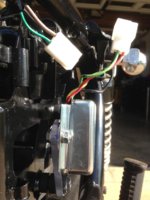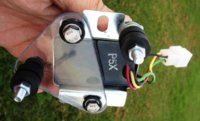Opus5150
XS650 Member
***FIXED***Wiring issue woes***FIXED***
Here's another fun PAMCO/PMA issue for you guys. Some background: 1972 xs650 with a 1975 engine. Complete kick only, no battery bobber rebuild. Purchased the Basic PAMCO High Output Electronic Ignition Kit / PMA Package through MikesXS on 6/29/13. Bike fired on first kick and ran OK until this afternoon when it just died on the road. No sputter, no other hints, just dead. Went through all the testing Pamco Pete mentioned on the site. Coil tests fine, capacitor tests fine, resistance as specified to test for looks fine. Everything but the Pamco test. If I rotate the magnet, we see no spark while connected to a good battery. I tried PM'ing and emailing Pamco Pete for some guidance, but I haven't heard anything back from him yet. Bought another Pamco unit from Mikes, but that one fried in less time. I know I'm getting too many volts and killing the Pamco, but I don't know from where. I'm hesitant to drop any more money on another unit until I have a better idea of why it's happening.
We used this schematic for the wiring:

Any help would be greatly appreciated. I hate seeing the bike go unridden.
Here's another fun PAMCO/PMA issue for you guys. Some background: 1972 xs650 with a 1975 engine. Complete kick only, no battery bobber rebuild. Purchased the Basic PAMCO High Output Electronic Ignition Kit / PMA Package through MikesXS on 6/29/13. Bike fired on first kick and ran OK until this afternoon when it just died on the road. No sputter, no other hints, just dead. Went through all the testing Pamco Pete mentioned on the site. Coil tests fine, capacitor tests fine, resistance as specified to test for looks fine. Everything but the Pamco test. If I rotate the magnet, we see no spark while connected to a good battery. I tried PM'ing and emailing Pamco Pete for some guidance, but I haven't heard anything back from him yet. Bought another Pamco unit from Mikes, but that one fried in less time. I know I'm getting too many volts and killing the Pamco, but I don't know from where. I'm hesitant to drop any more money on another unit until I have a better idea of why it's happening.
We used this schematic for the wiring:

Any help would be greatly appreciated. I hate seeing the bike go unridden.
Last edited:




